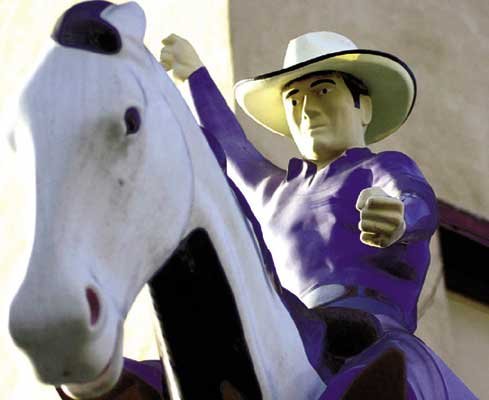Those responsible for Casey Tibbs are guarding him like a
national secret.
Those responsible for Casey Tibbs are guarding him like a national secret.
The statue of the famous bronco rider and his bucking horse, War Paint, disappeared last summer, more than 50 years after the real life pair delighted rodeo-enthused Gilroyans. George Hall sold his downtown property at 7401 Monterey St. – near the corner of Sixth Street and caddy corner from Old City Hall – last summer and subsequently removed the iconic duo from the building’s facade.
Since then, The Dispatch tracked Tibbs and War Paint down to Hogue Bros. Collision Center, near Welburn Avenue and Church Street. When asked in person about the statue earlier this summer, employees there refused to answer questions and forced a reporter out of the shop. That was right around the time the statue left the property after sitting in storage for nearly a year, according to Manager Dominique Boffa. He denied that his employees had the statue and that he did not know where Tibbs had galloped off to.
Multiple calls to Hall’s residence went unanswered, as did a note left in his mailbox and a series of visits to the his rural house outside of Morgan Hill. The only response to inquiries was a playful e-mail from Hall’s wife, Joanne Hall: “Man and beast doing very well. No unusual distress!”
While insouciance seems to abound, others wonder where the pair that watched over downtown has gone after more than 50 years. Gilroy Historical Society President Connie Rogers noted the close relationship between the Halls and Hogues and said she expects the families to reintroduce Tibbs sometime soon. However, Boffa could not confirm this or provide any details.
“I don’t know where (the statue) went,” Boffa said in between a few chuckles on the phone Monday. “It’s kind of interesting there’s been so much stir over this.”
A few years ago, Tibbs and his horse received some aesthetic refreshment in anticipation for a move to Gilroy Gardens, but that never happened. Then, having caught wind of the building’s sale in late 2007, the city’s Public Arts Committee sent a letter to the Halls asking that they not let anything happen to the statue. The committee suggested the statue be placed downtown, like a monument, Rogers said. The committee never received a definite reply, Rogers said, and neither did the Gilroy Museum, according to employees there.
As far as the building itself, the Halls ran Hall’s Western Wear at that corner until the early 1990s after taking over from George Hall’s father, Bill, who opened the shop in 1931. Known officially as the James Ellis building, it opened in 1872 and is the oldest building on the block.
Another memory of the saddle bronco-riding competitions Tibbs participated in, known as gymkhanas, existed in the artistic frieze above the now-closed bar at the Harvest Time Restaurant, below the Milias Apartments at the same intersection. The building used to be a hotel where the gymkhana committee would meet and drink.
Despite all his local fame, Tibbs hailed from South Dakota. Locals here loved him because he dominated the rodeo scene that took off after World War II. At age 19, in 1949, Tibbs became the youngest man to win the national saddle bronco-riding crown, according to the Casey Tibbs Foundation. And between 1949 and 1955, he won six such championships, which is still a record.












